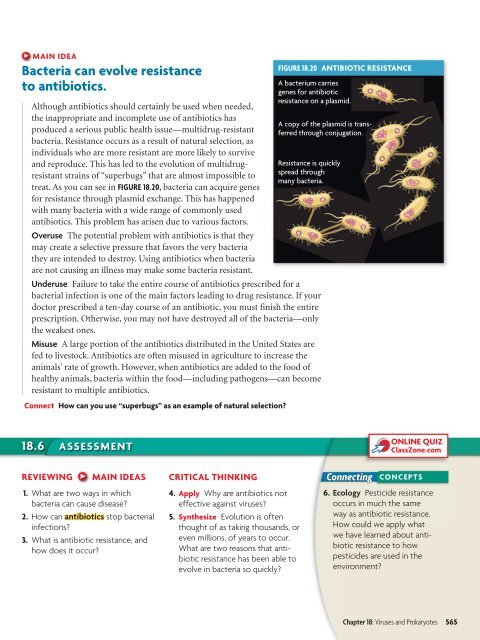18.1 Studying Viruses and Prokaryotes
18.1 Studying Viruses and Prokaryotes
18.1 Studying Viruses and Prokaryotes
Create successful ePaper yourself
Turn your PDF publications into a flip-book with our unique Google optimized e-Paper software.
MAIN IDEABacteria can evolve resistanceto antibiotics.Although antibiotics should certainly be used when needed,the inappropriate <strong>and</strong> incomplete use of antibiotics hasproduced a serious public health issue—multidrug-resistantbacteria. Resistance occurs as a result of natural selection, asindividuals who are more resistant are more likely to survive<strong>and</strong> reproduce. This has led to the evolution of multidrugresistantstrains of “superbugs” that are almost impossible totreat. As you can see in FIGURE 18.20, bacteria can acquire genesfor resistance through plasmid exchange. This has happenedwith many bacteria with a wide range of commonly usedantibiotics. This problem has arisen due to various factors.Overuse The potential problem with antibiotics is that theymay create a selective pressure that favors the very bacteriathey are intended to destroy. Using antibiotics when bacteriaare not causing an illness may make some bacteria resistant.Underuse Failure to take the entire course of antibiotics prescribed for abacterial infection is one of the main factors leading to drug resistance. If yourdoctor prescribed a ten-day course of an antibiotic, you must finish the entireprescription. Otherwise, you may not have destroyed all of the bacteria—onlythe weakest ones.Misuse A large portion of the antibiotics distributed in the United States arefed to livestock. Antibiotics are often misused in agriculture to increase theanimals’ rate of growth. However, when antibiotics are added to the food ofhealthy animals, bacteria within the food—including pathogens—can becomeresistant to multiple antibiotics.Connect How can you use “superbugs” as an example of natural selection?FIGURE 18.20 ANTIBIOTIC RESISTANCEA bacterium carriesgenes for antibioticresistance on a plasmid.A copy of the plasmid is transferredthrough conjugation.Resistance is quicklyspread throughmany bacteria.18.6 ASSESSMENTONLINE QUIZClassZone.comREVIEWINGMAIN IDEASCRITICAL THINKINGConnecting CONCEPTS1. What are two ways in whichbacteria can cause disease?2. How can antibiotics stop bacterialinfections?3. What is antibiotic resistance, <strong>and</strong>how does it occur?4. Apply Why are antibiotics noteffective against viruses?5. Synthesize Evolution is oftenthought of as taking thous<strong>and</strong>s, oreven millions, of years to occur.What are two reasons that antibioticresistance has been able toevolve in bacteria so quickly?6. Ecology Pesticide resistanceoccurs in much the sameway as antibiotic resistance.How could we apply whatwe have learned about antibioticresistance to howpesticides are used in theenvironment?Chapter 18: <strong>Viruses</strong> <strong>and</strong> <strong>Prokaryotes</strong> 565
















